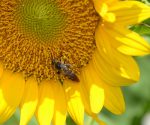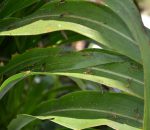
Gohar Umar
Extension Agent FAMU
Nature has a way of making life as easy as possible, but it will not happen fast so planning is critical to success. One means is by putting some plants (trap crops) which attract beneficial and/or destructive insects.
Insects are one of the main challenges in growing vegetable garden. Warm weather and high humidity in Leon County promotes the growth and expansion of insect populations.
To control insects many people use insecticides as the initial approach to save time and labor. However, solely relying on insecticides will cause insecticide resistance long term in the insect population. Also, if improperly used it might end up on your table with your produce.
Trap cropping is another effective way to control insects by installing an attractive plant near to the higher value primary crop. It is very economical, has potential health benefits for consumers of the vegetables and is safe for pets and beneficial insects.

Trap cropping is based on the principle of host inclination, that is to say, insects will prefer a different plant than the one harvested as produce. Studies have been done by numerous scientists on trap crops and their use for various insect pests.
University of Missouri with USDA/ARS conducted a study on cucumber beetles and squash bugs. Their results were very promising as they were attracted more towards Blue Hubard squash and Buttercup squash than their main crop Zucchini.
Leaf-footed bug has been a menace in tomato production, both commercial and in home gardens. The results from Wakulla County extension Office and Center for Viticulture and Small Fruits Research, FAMU has shown clearly Sorghum and sun flower have very promising results for attracting those insects if staggered in blooming intervals.

Yet another purpose of trap crops is their use in drawing natural enemies or predator insects to the garden. These crops are often referred to as refuge crops. As the insects come for the pollen on these plants and they find other insects which they can feed on.
Sweet alyssum and buckwheat are good examples of refuge trap crops. They attract wasp and Hoverflies. Hoverflies lay eggs on leaves, which hatch into maggots which feed on aphids and mealy bugs. Wasps lay eggs on caterpillars which hatch and feed on them. Bees are also attracted to these crops which aids in pollination.

The correct use of trap crops has shown the potential for a 10-30% increase in net returns, mainly through lower use of insecticides and the associated cost reduction.
So plant the trap crops and let the beneficial insect attach the pest species. Letting the bugs take care of themselves is the best of both worlds, gardeners save the money and the predators do the work.
Gohar Umar is an Extension Agent with FAMU and Les Harrison is the Extension Director with UF/IFAS Wakulla County Extension Office. For gardening question, email us at AskAMasterGardner@ifas.ufl.edu
 0
0
